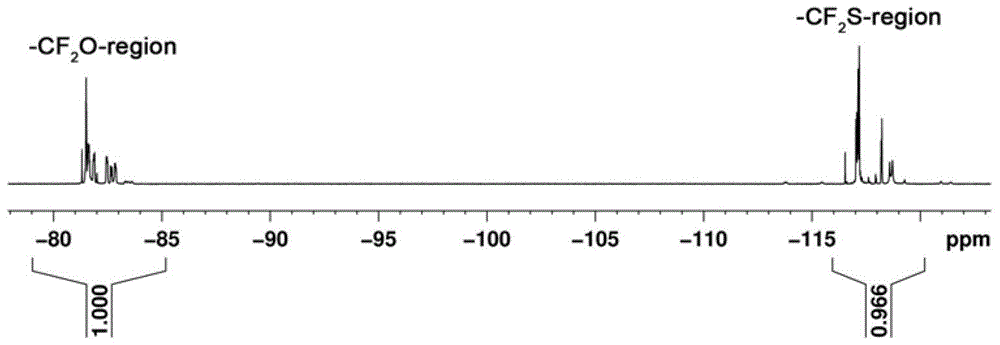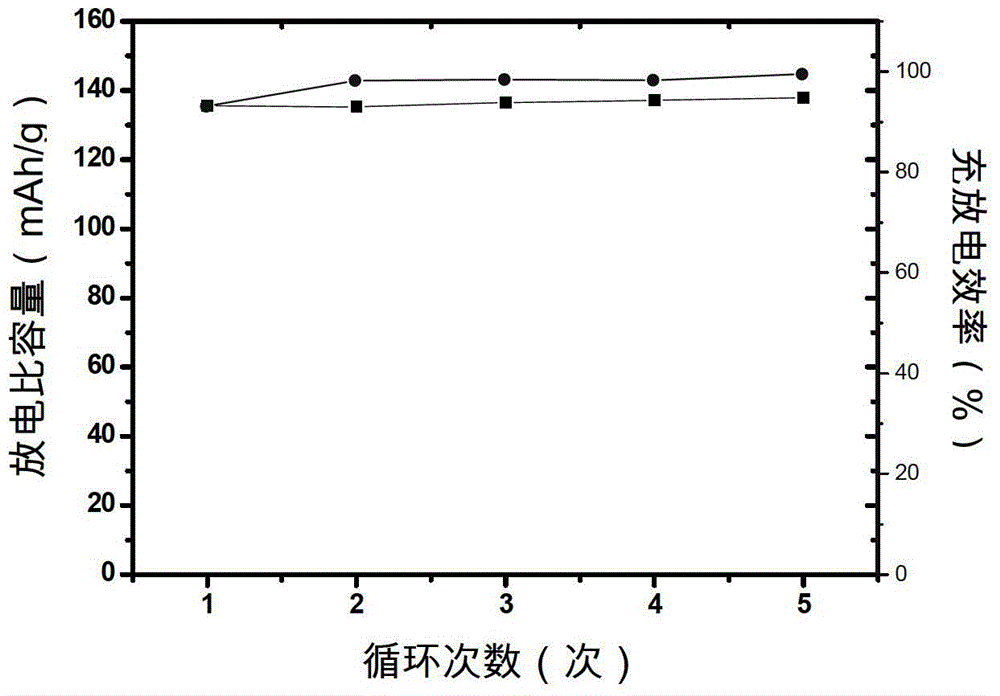Conductive binder for positive electrode of lithium ion battery, positive electrode of lithium ion battery and preparation method
A lithium-ion battery and conductive binder technology, applied in battery electrodes, non-aqueous electrolyte battery electrodes, secondary batteries, etc., can solve the problems of increased internal resistance of electrode materials, low ionic conductivity, and increased polarization resistance, etc. Achieve the effect of improving battery capacity, high lithium ion conductivity, and high ion conductivity
- Summary
- Abstract
- Description
- Claims
- Application Information
AI Technical Summary
Problems solved by technology
Method used
Image
Examples
Embodiment 1
[0038] In this embodiment, the conductive binder for the positive electrode of the lithium ion battery is a fluorine-containing sulfonimide lithium ion polymer (PFSI), and its structural formula is:
[0039]
[0040] Wherein, n is an integer from 500 to 1000, including 500 and 1000.
[0041] The preparation method of the above binder is: dissolving fluorine-containing sulfonimide ion polymer salt PFSI in acetonitrile, adding an equivalent amount of LiClO 4 , stirred and lithiated for 12 hours, filtered, removed the solvent, and dried thoroughly in a vacuum oven at 80°C to obtain a fluorine-containing sulfonimide lithium ion polymer, which was put into a desiccator for use.
[0042] The 19FNMR characterization figure of the fluorine-containing sulfonimide lithium ion polymer prepared above is as follows figure 1 shown. The measured number average molecular weight is 355775, and the average degree of polymerization is 830.
[0043] When using the fluorine-containing sulfon...
Embodiment 2
[0048] In this example, the conductive binder for the positive electrode of the lithium ion battery is a mixture of the fluorine-containing sulfonimide lithium ion polymer (PFSI) and polyvinylidene fluoride (PVDF) in Example 1 at a mass ratio of 1:1. made.
[0049] The preparation method of the fluorine-containing sulfonylimide lithium ion polymer (PFSI) is the same as that of Example 1.
[0050] The above-mentioned binder is used to make the positive electrode sheet of the lithium ion battery. The positive electrode sheet is based on a current collector aluminum foil, and an active material layer is coated on the surface of the base material. The active material layer is lithium iron phosphate LiFePO 4 The powder is used as the positive electrode active material, acetylene black is used as the conductive agent, and the mixture of the above-mentioned fluorine-containing sulfonimide lithium ion polymer (PFSI) and polyvinylidene fluoride (PVDF) at a mass ratio of 1:1 is used a...
Embodiment 3
[0061] In this embodiment, the conductive binder for the positive electrode of the lithium ion battery is the same as the binder for the positive electrode of the lithium ion battery in Example 1.
[0062] The preparation method of the binder is as follows: exchange the fluorine-containing sulfonimide ion polymer salt with a Nafion-H ion exchange column for hydrogen ion exchange, then add an equivalent LiOH solution and stir for lithiation for 12 hours, remove the solvent, and dry it in a vacuum oven Thoroughly dry at 80°C to obtain a fluorine-containing sulfonimide lithium ion polymer conductive adhesive, which is placed in a desiccator for use.
[0063] A lithium ion battery material using the above-mentioned binder. The positive electrode material is based on a current collector aluminum foil, and an active material layer is coated on the surface of the base material. The active material layer is lithium manganate (LiMn 2 o 4 ) powder as the positive electrode active mat...
PUM
| Property | Measurement | Unit |
|---|---|---|
| degree of polymerization | aaaaa | aaaaa |
Abstract
Description
Claims
Application Information
 Login to View More
Login to View More - R&D
- Intellectual Property
- Life Sciences
- Materials
- Tech Scout
- Unparalleled Data Quality
- Higher Quality Content
- 60% Fewer Hallucinations
Browse by: Latest US Patents, China's latest patents, Technical Efficacy Thesaurus, Application Domain, Technology Topic, Popular Technical Reports.
© 2025 PatSnap. All rights reserved.Legal|Privacy policy|Modern Slavery Act Transparency Statement|Sitemap|About US| Contact US: help@patsnap.com



